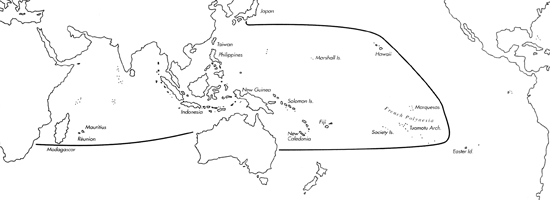Range: Entire Indo-Pacific.
Description: Medium-sized to moderately large, moderately solid to moderately heavy. Last whorl conical to broadly conical, sometimes slightly ventricosely conical; outline variably convex at adapical fourth or third and almost straight below, often slightly concave centrally in large specimens. Shoulder angulate to subangulate. Spire usually low, outline slightly concave to slightly convex. Teleoconch sutural ramps flat to slightly concave; later ramps with numerous spiral striae, with 3-6 spiral grooves, or with intermediate sculpture. Last whorl with distinct to obsolete, well-separate spiral ribs basally, sometimes granulose; these ribs weaker adapically, and any extending above centre are absolete and not granulose.
| Shell Morphometry | ||
|---|---|---|
| L | 35-75 mm | |
| RW | 0.25-1.00 g/mm | |
| (L 35-65 mm) | ||
| RD | 0.58-0.73 | |
| PMD | 0.83-0.92 | |
| RSH | 0.01-0.13 | |
Colour light yellowish to orange or pinkish brown, occasionally brownish green. Last whorl with a pale or white spiral band at or closely below centre and at shoulder; shoulder band sometimes and central band seldom absent. Base purplish blue. Larval whorls change colour from white to purple during metamorphosis (Perron, 1981a). Postnuclear sutural ramps vary from white to colour of last whorl. Aperture violet to purplish blue, with pale bands near centre and below shoulder.
Periostracum grey to brown, thick, opaque and rather smooth to fibrous, transversely ridged in subadult specimens (Kohn, 1959a; Cernohorsky, 1964; Estival, 1981).
Dorsum of foot mottled grey and brown, with white dots; median area lighter; anterior and posterior parts with a black medial transverse blotch. Anterior side of foot sometimes white to yellow. Sole of foot buff, mottled and streaked with brown and with a few scattered white dots. Rostrum yellow grading to yellowish brown dorsally, sometimes mottled with darker brown. Tentacles white, yellow or yellowish brown, sometimes mottled with brown or black dorsally. Siphon grey to dull yellow, edged with yellow and often dotted with white, with a black band anterior to the centre and a grainy dark grey band posterior to it; proximal part may be mottled with black (Garrett, 1878; Kohn, 1959a & unpubl. observ.; Pearson, unpubl. observ.; Fainzilber et al., 1992) (Pl. 81, First row).
Radular teeth with an adapical barb opposite a blade; long serration down to or beyond the centre of the shaft, terminating in a backward-pointing cusp; base with a distinct spur (Bergh, 1895; James, 1980). Bandel (1984) depicts a much shorter serration without a cusp.
Habitat and Habits: On intertidal benches and more frequently on shallow subtidal reef flats to about 20 m; ranging from inshore habitats to the reef rim and inhabiting small sand-filled depressions, reef limestone or beachrock with or seldom without algal turf, coral rubble with or without sand, and dead coral heads or rocks. C. flavidus feeds on sedentary polychaetes of the families Terebellidae , Maldanidae and Capitellidae, rarely consuming enteropneusts; diet composition varies depending on habitat and locality (Kohn, 1959b, 1968b; Leviten & Kohn, 1980; Reichelt & Kohn, 1985; Marsh, 1971; Fainzilber et al., 1992). Egg capsules of 8.5-14 x 6.5-11 mm have a short stalk and are deposited in parallel rows under rocks on subtidal reef flats or near the reef crest. Egg diameter of 175-223 ┬Ám suggests a minimum pelagic period of 26-21 days. Larvae settled after a planktonic period of 23 days in Hawaii (Cernohorsky, 1964; Perron, 1981 a-c; Perron & Kohn, 1985; Loch, pers. comm., 1987).
Discussion: C. flavidus is often very difficult to distinguish from C. frigidus and also resembles C. emaciates. The latter species has a lighter shell with a generally narrower, more conical and less smooth ;ast whorl; the largely white aperture distinguishes it clearly from C. flavidus. For distinction from C. frigidus, see the Discussion of that species. C. lividus resembles C. flavidus in size, shape and colouration but is distinguished by its tuberculate postnuclear whorls.

C. flavidus range map
This section contains verbatim reproductions of the accounts of 316 species of Conus from the Indo-Pacific region, from Manual of the Living Conidae, by R÷ckel, Korn and Kohn (1995). They are reproduced with the kind permission of the present publisher, Conchbooks.
All plates and figures referred to in the text are also in R÷ckel, Korn & Kohn, 1995. Manual of the Living Conidae Vol. 1: Indo-Pacific Region.
The range maps have been modified so that each species account has it own map, rather than one map that showed the ranges of several species in the original work. This was necessary because each species account is on a separate page on the website and not confined to the order of accounts in the book.